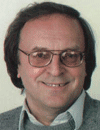Wilhelm Ansorge
Professor, Ecole Polytechnique Federale de LausanneProfessor Wilhelm J. Ansorge EPFL, (ETH Lausanne).
Short description of background :
Dissertation in : Magnetic properties of materials at cryogenic temperatures.
Texas Instruments Inc., Dallas.,-. Semiconductor technology and development.
CERN, Geneva,- Construction of Superconducting magnets and Components, Computer system control.
EMBL, Heidelberg,-Biomedical Technology, Instruments and Techniques development, commercialized by by my Department at European Molecular Biology Laboratory and leading European industry.
At present at EPFL, serving on several European Scientific Advisory Boards. Continued interest in innovative DNA analysis and other genomics tools.
DNA Sequencing Systems :
Development and construction of five generations, starting with Ultra-thin Gel Technique, to High-throughput Fluorescent multiple lasers sequencing systems. (Commercialized by LKB, Pharmacia Amersham).
The technique was used for determination of the first human Gene locus (HPRT) 60 kb sequence, published 1992, proving feasibility of the technology for analysis of complex genome projects. Furthermore were sequenced human chromosomal DNA for clinical projects. We participated in sequencing of yeast (largest contribution in continental Europe), genomic and mitochondrial DNA in Arabidopsis, parts of Drosophila and Anopheles. First analysis of gene expression in yeast on low carbon diet by SAGE technique.
Already in 1991 I submitted one of the first patent applications for a DNA sequencing system without gels, fluorescent "Sequencing by Synthesis", similar to those used today in US, in the so called Next-generation systems.
Other contributions from the EMBL department include :
Automated Microinjection in single cells (Zeiss, Eppendorf), Electro-Transfection(Eppendorf),
Ultrathin Gel Technique for DNA and protein analysis, DNA Synthesiser, Protein Synthesiser,
Mass Spectrometry from Gel+Fingerprint, Nano-electrospray Mass Specs,
1st Whole Genome Chip (52000cDNAs) in 2001, Development of software, robotics and automation.
Membership and Honors :
EMBO, HUGO, HUPO. ( Honorary degree from the Charles University in Prague, 1992.)
Publications, Patents and Technology Transfer
Over 300 publications, Reviews, 3 books (Techniques, Molecular Diagnostics),
Over 30 patent applications, resulting in several commercial products by leading European companies.
Involved in Technology Transfer, founder of one Biotech company.
|  |

 Add to Calendar ▼2014-05-14 00:00:002014-05-15 00:00:00Europe/LondonAdvances in NGS and Big DataAdvances in NGS and Big Data in Barcelona, SpainBarcelona, SpainSELECTBIOenquiries@selectbiosciences.com
Add to Calendar ▼2014-05-14 00:00:002014-05-15 00:00:00Europe/LondonAdvances in NGS and Big DataAdvances in NGS and Big Data in Barcelona, SpainBarcelona, SpainSELECTBIOenquiries@selectbiosciences.com